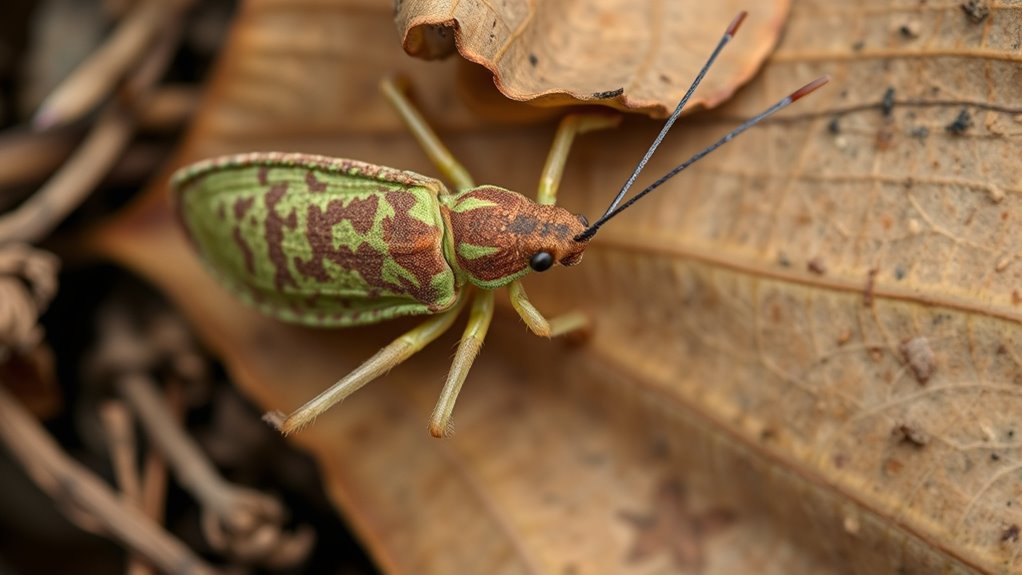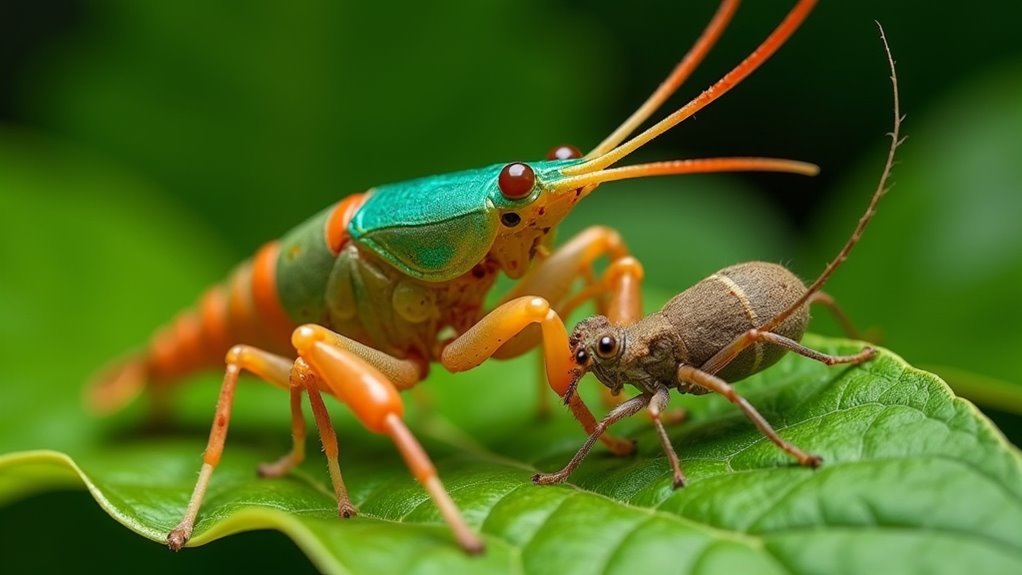Animals have some truly bizarre and clever ways to protect themselves. You might be amazed by creatures that blend perfectly into their surroundings with camouflage, like leaf-tailed geckos or stick insects. Others use chemical warfare, spraying foul odors or toxic substances to deter predators. Bright warning colors, known as aposematism, signal danger, while some combine these tactics for layered defenses. If you’re curious about these incredible survival tricks, there’s plenty more fascinating strategies to discover.
Key Takeaways
- Animals like leaf-tailed geckos mimic fallen leaves with jagged edges and mottled colors for seamless camouflage.
- Bombardier beetles eject boiling chemical sprays as fiery defenses against predators.
- Skunks spray pungent, noxious liquids to deter threats with a foul odor.
- Poison dart frogs display bright warning colors (aposematism) signaling toxicity to predators.
- Some animals combine visual camouflage with chemical defenses for layered, effective protection.

Have you ever wondered how animals manage to survive threats from predators and environmental dangers? It’s fascinating to see the clever ways they defend themselves, often using tactics that seem straight out of a survival manual. One of the most common strategies is camouflage tactics. Animals such as chameleons, stick insects, and leaf-tailed geckos blend seamlessly into their surroundings, making it nearly impossible for predators to spot them. These creatures have evolved colors, patterns, and textures that mimic their environment perfectly, allowing them to hide in plain sight. For example, a leaf-tailed gecko’s body resembles a fallen leaf, complete with jagged edges and mottled coloration. This kind of visual disguise is incredibly effective, especially in environments with dense foliage or complex backgrounds. By staying hidden, animals reduce their chances of becoming prey, conserving energy and avoiding confrontation altogether.
But camouflage isn’t the only trick up their sleeves. Many animals also rely on chemical deterrents to ward off threats. When predators do manage to get close, these creatures often release noxious substances or emit foul odors to discourage attack. Skunks are a classic example: they spray a strong, pungent liquid that can cause irritation and confusion, giving the skunk enough time to escape. Similarly, bombardier beetles eject a boiling chemical spray from their abdomen, creating a fiery defense that deters many would-be predators. Some frogs and toads produce toxic skin secretions that can cause pain or even poisoning if ingested or touched. These chemical deterrents are often combined with bright warning colors—aposematic signals—that alert predators to the animal’s toxicity or bad taste. This visual cue acts as a warning sign, preventing attacks before they even happen.
Both camouflage tactics and chemical deterrents showcase how animals have evolved diverse and effective defenses. Camouflage allows them to avoid detection altogether, while chemical deterrents serve as a last line of defense when escape isn’t possible. These strategies are often used in tandem, providing a layered approach to survival. For instance, a brightly colored poison dart frog might sit quietly in the underbrush, relying on its vivid warning signals to keep predators at bay, while also blending in with the vibrant environment when necessary. The ingenuity behind these defense mechanisms highlights nature’s incredible ability to adapt and survive in a world filled with dangers. Whether by hiding in plain sight or fighting fire with fire, animals continually demonstrate that survival depends on clever, sometimes bizarre, solutions.
Frequently Asked Questions
Do Animals Ever Use Mimicry to Deceive Predators?
Yes, animals do use mimicry to deceive predators. You’ll often see mimicry in insects, where they imitate other animals or objects to stay safe. They rely on deceptive camouflage techniques, blending in with their surroundings or mimicking the appearance of more dangerous creatures. By doing so, they trick predators into thinking they’re not worth attacking, giving themselves a better chance to survive and reproduce.
How Do Some Animals Change Color Rapidly for Defense?
You might be amazed by how some animals use rapid color change for protection. Chameleons, for example, utilize specialized skin cells called chromatophores to achieve chameleon camouflage, blending into their surroundings quickly. When threatened, they rapidly change color, signaling danger or confusing predators. This ability allows them to stay hidden or communicate with others, making their defense mechanisms highly effective and fascinating to observe.
Are There Animals That Use Acoustic Signals as a Defense?
Imagine you’re in a dark forest, and suddenly, a sound mimics your surroundings. Some animals use acoustic signals as a defense, employing sound camouflage or acoustic decoys to deceive predators. For example, certain insects and frogs produce calls that blend into environmental noise or mimic other species’ sounds, confusing predators and increasing their chances of escape. This clever use of sound helps them stay safe in their natural habitats.
Can Animals Defend Themselves Without Physical or Chemical Means?
You might wonder if animals can defend themselves without relying on physical or chemical means. Yes, they do! Many use camouflage strategies to blend into their environment, making it hard for predators to spot them. Others employ behavioral tactics, like playing dead or creating distractions. These clever approaches allow animals to stay safe without physical confrontation or chemical defenses, showcasing the diversity of nature’s survival strategies.
Do Animals Collaborate to Protect Each Other From Predators?
You might wonder if animals team up to defend each other. Often, they do, using behaviors like mutual grooming to strengthen bonds and alarm calling to warn others of danger. When one animal spots a predator, it alerts the group, prompting collective defense. This cooperation increases everyone’s survival chances, showing that animals frequently collaborate to protect themselves and their community from threats.
Conclusion
As you explore these bizarre animal defenses, you realize nature’s own symphony of survival. Each creature dances to its own clever tune—some cloaked in mimicry, others shining with shocking colors. Their strategies are like hidden traps in a jungle maze, waiting to surprise and protect. So next time you marvel at these strange defenses, remember, in the wild’s grand orchestra, every note is a bold, brilliant act of survival—an unexpected harmony of cleverness.










